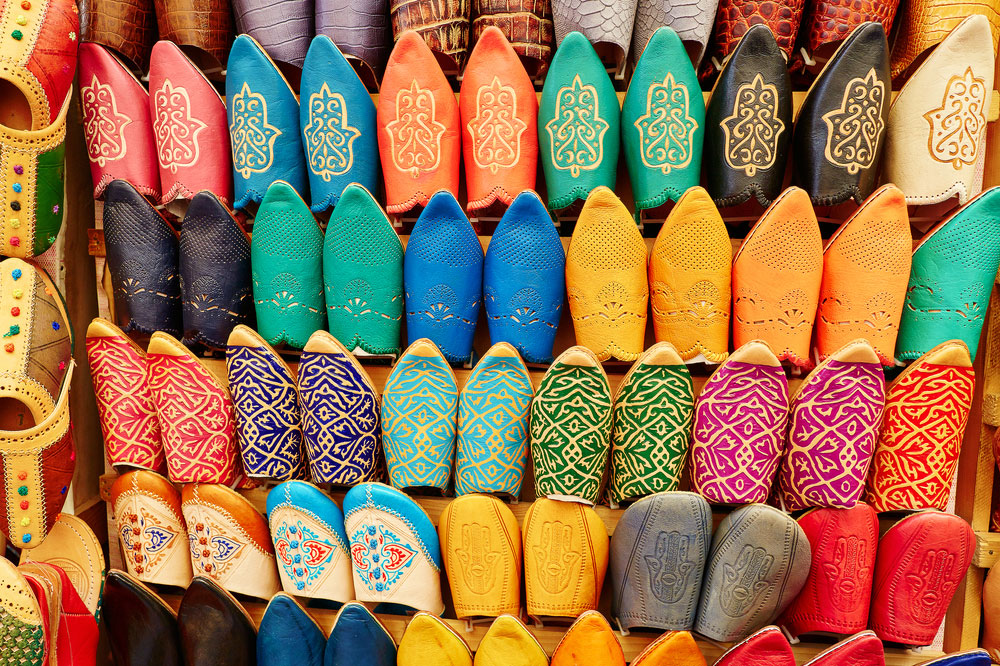History & Heritage
8.23.2021
5 things you didn’t know about babouche

A small, comfortable and light shoe, the babouche can be found everywhere, and it is very likely that you have one (or ten) pairs. Its particularity and popularity are not only due to its practicality and affordability: it is the pride of the Arab world and particularly of Morocco, and is one of its flagship products.
1. An ancestral craftsmanship
Babouches (from the Persian papush – pa, foot, and push, cover) have a history that goes back centuries: in fact, it is estimated that they appeared in the 3rd century BC! They appeared in the Arab-Muslim world and were worn by women in order to hide their toes, out of modesty. Men quickly adopted them for their convenience.
This convenient aspect is what the babushiers, as they are called nowadays, are looking for. They pass on from generation to generation a precise and delicate savoir-faire.
It takes them about 10 hours to make a pair of these slippers. The babouchier must always keep his hands dry and clean before handling the grained goat skin that will compose the upper part of the shoe, or the calf skin that will compose the sole.
Also, leather will be needed to produce a pair of shoes, and not just any leather: it comes from the tanneries of the Medina Boujloud in Fez, Morocco, renowned for the quality of their leather.
The assembly of the skins and leather is done with silk and nylon threads, and in three different ways: by hand, by machine and by glue.
Once assembled, the slippers are smoothed with soap to hide the visible seams. The last step is to remove the leather scraps hanging off the sole for a more aesthetic effect.
And that’s it!
2. A shoe for everyone
Men, women, children, from Maghreb, Middle East or the whole world, all have adopted the famous pair of slippers. Everyone chooses his pair of belgha (for men) or charbil (for women) according to his tastes: bright colors, plain or embroidered.
Whatever the model, their timeless nature make the shoes a perfect match for both traditional and fashionable outfits.
For example, during celebrations and weddings, a pair with patterns, embroidery and other decorations will be preferred, while a pair for everyday use at home will be more simple.
This popularity and diversity goes back to the early days of the babouche, as everyone wore them, regardless of social class, nomads or sedentary, rural or urban, rich or poor.
However, Arabs, and particularly Moroccans, are fighting to preserve this halfway between modernity and tradition heritage, dear to their culture and to their hearts.
See also
undefined3. A very versatile shoe
Due to the richness and particularities of each region and country, there are dozens of kinds of babouches. We can distinguish two main types of babouches especially in Morocco, namely the Berber babouche, which is more rural and the Arab babouche, a more urban one.
The first one has round or square ends while the second one has pointed ends.
The Berber babouche is very solid, since it has a rubber sole in particular, most of the time. It is used outdoors and has a leather lining inside for an antiperspirant effect.
Comfortable and appropriate!
The more urban pair, with pointed toes, also called “traditional babouche” is made of leather or sabra (vegetable silk). It is very elegant and its shape immediately recalls the Eastern culture.
We can also mention a new kind of babouche, similar to the mule or the mocassin, which are very fashionable. Taking the flexibility and lightness of the original model, they are leather and are all the rage with great designers or big houses such as Dior or Gucci.
A proof of the popularity and the versatility of this pair!
4. A Symbol of the Eastern World
The papouch, word used in French in 1542, then babouche spread in Europe, popularized by the colonial expeditions to North Africa and also through the arts.
Indeed, it quickly became fashionable, since it suggested exotism and discovery. For Westerners, it is more than a shoe: it embodies a wholeway of life, a rich, lustful, mysterious and fascinating one.
Elites were seduced and adjusted the pair to the trends of the time: they covered it with embroidery and added a heel.
At the same time, the orientalist painters spread and popularized its image even more : we can quote Eugene Delacroix who brought a pair back from Tangier in 1822, and depicted it many times in his works. Matisse painted his Zohra on the terrace in 1912, and carried out a chromatic experiment through its yellow, blue and carmine slippers.
A year earlier, in 1911, the Shéhérazade ballet showed dancers wearing babouches instead of the classic pointe shoes: the babouche represented creativity.

5. A real Moroccan ambassador
Nowadays, this shoe is at the center of Moroccan leather craftsmanship and is one of the most popular objects among tourists. Marrakech is even the first city of production of babouches. But this required certain steps in history.
Indeed, the establishment of the French protectorate over Morocco in 1912 led to ethnographic surveys that defined standards for the pair, in order to preserve Moroccan craft and expertise. It was also a way to protect themselves from counterfeiting and foreign competition and in particular Japanese competition, since they also have a form of babouche, or rather slippers.
In 1934, the entry of foreign slippers on the territory of the protectorate was prohibited by a decree. In 2011, the Moroccan government decided to increase customs duties on slippers manufactured abroad, and to label the shoe whose characteristics were set by a new decree.
However, the babouches are popular worldwide and know no borders.
popular

